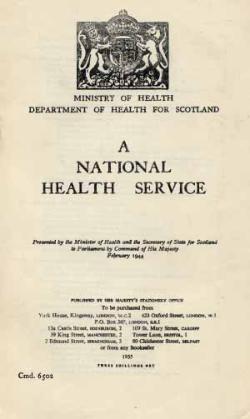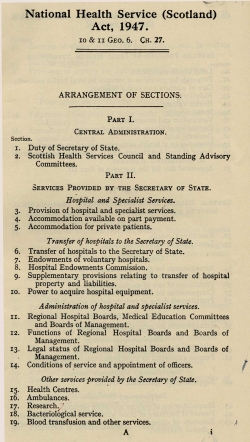A Healthy Start - Before the NHS
 Image left: Department of Health for Scotland, National Health Service document, 1944
Image left: Department of Health for Scotland, National Health Service document, 1944
The creation of the National Health Service meant that medical care was available free to everybody in Britain for the first time. In England this was revolutionary, and was opposed by many in the medical profession. But Scottish medicine had been moving in this direction for some time.
In the cities, hospitals were closely linked to the medical schools of the Scottish universities, and doctors had an important status as academic staff. This meant they did not have to rely on lucrative private practice as in England.
In 1913 the Highlands & Islands Medical Service was established, providing state-funded medical care to an area that covered half the country. Administered by the Scottish Office it provided doctors and nurses to remote communities. In the 1930s the scheme was extended to hospitals, and an air ambulance service was introduced. It proved an important prototype for the NHS itself.
Scotland was also home to a major programme of state-funded hospital building during the Second World War, on a scale unrivalled throughout Europe. Existing hospitals were expanded and seven new hospitals were built, including Bridge of Earnand Stracathro.
The NHS had another important blueprint in the Cathcart Report, commissioned by the Secretary of State for Scotland in 1933. It was a radical and visionary report on the future of Scottish healthcare, and was much quoted when the NHS (Scotland) Bill was presented in 1946.
In 1942, Sir William Beveridge set out in a report his vision of a post-war Welfare State that would banish the five evil giants of want, ignorance, squalor, idleness and disease. Uniquely for a Government report, it became a best seller.
 Aneurin Bevan was the charismatic Labour politician who launched the National Health Service on 5 July 1948, with the promise that “everybody, irrespective of means, age, sex or occupation shall have equal opportunity to benefit from the best and most up-to-date medical and allied services together”.
Aneurin Bevan was the charismatic Labour politician who launched the National Health Service on 5 July 1948, with the promise that “everybody, irrespective of means, age, sex or occupation shall have equal opportunity to benefit from the best and most up-to-date medical and allied services together”.
The greatest early impact was where previously there had been limited or no public provision. Now everyone had free access to proper medicines on prescription, surgical repair of hernias, dentures, spectacles and hearing aids. The demand was overwhelming.
Image right: National Health Service Scotland Act, 1947